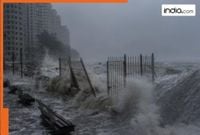As dawn broke on Monday, September 29, 2025, central and northern Vietnam awoke to the full force of Typhoon Bualoi, the tenth typhoon to strike the country this year. The storm, which had already left a deadly trail across the Philippines, swept into Hà Tĩnh province with winds reaching up to 133 kilometers per hour and torrential rain, unleashing chaos and destruction across a broad swath of the nation.
Authorities, bracing for the worst, mounted one of Vietnam’s largest evacuation efforts in recent memory. According to Vietnam News, more than 210,000 people in Đà Nẵng were relocated to safer ground, while Huế city moved over 32,000 residents from coastal and low-lying areas. In Hà Tĩnh alone, over 15,000 people found refuge in schools and health centers hastily converted into temporary shelters. Across several provinces including Thanh Hóa, Hà Tĩnh, and Quảng Trị, the government reported the evacuation of nearly 30,000 residents in coastal zones, with the total number of displaced people climbing as the storm’s impact widened.
The scale of the response was staggering. More than 117,000 soldiers were mobilized to help with evacuations, reinforce flood defenses, and support search-and-rescue operations. The Civil Aviation Authority of Vietnam suspended operations at four coastal airports—including the busy Đà Nẵng International Airport—leading to dozens of flight cancellations and delays. All fishing boats along the typhoon’s projected path were ordered back to port, a precaution that likely saved countless lives.
But despite these efforts, tragedy struck. At least one person was confirmed dead—a woman who succumbed to floodwaters in Huế, as reported by Viet Nam News. Four others, including three in Quảng Trị and one in Đà Nẵng, remain missing. The storm damaged at least 86 homes, ripped off corrugated metal roofs, toppled concrete utility poles, and left more than 347,000 households without electricity. "No one dares to go outside," said Le Hang, a resident, to VNExpress, capturing the palpable fear sweeping through communities as the winds howled and rain battered the region.
Typhoon Bualoi’s impact was not confined to Vietnam. Just days before, the storm had lashed the Philippines, claiming at least 20 lives—many lost to drowning or falling trees—and forcing more than 23,000 families into over 1,400 emergency shelters. The storm’s path through the archipelago left widespread power outages and devastation in its wake, further straining resources already stretched by the earlier Typhoon Ragasa, which had killed at least 28 people across the Philippines, Taiwan, China, and northern Vietnam.
In Vietnam, meteorologists from the National Centre for Hydro-Meteorological Forecasting warned that the worst might not be over. Heavy rains were forecast to continue through October 1, with rainfall expected to reach between 150 and 250 millimeters in the central provinces of Nghệ An, Thanh Hóa, and Hà Tĩnh. In some areas, totals could exceed 350 millimeters. River levels were projected to rise by as much as nine meters, dramatically increasing the risk of flooding and landslides. The storm’s slow movement, according to Deputy Director Hoang Phuc Lam, meant that “winds and rain would persist for a longer duration, increasing the risk of damage and flooding.”
Prime Minister Pham Minh Chinh issued an emergency directive, calling on ministries, local governments, and the armed forces to mobilize all available resources to address the typhoon’s impacts. The directive prioritized the immediate evacuation of residents from danger zones, management of flood-prone areas, and rapid restoration of critical infrastructure such as electricity, clean water, and telecommunications. Schools, health clinics, and damaged homes were ordered to be repaired as quickly as possible.
In Đà Nẵng, city officials prepared for the relocation of more than 210,000 people, while the city of Huế in the north planned to move over 32,000 residents. In Huế, the streets of low-lying neighborhoods were already inundated after heavy rain began pouring down on Saturday night. The wind had blown off the roofs of houses, and at least one person was reported missing after being swept away by floodwaters.
For many Vietnamese, this relentless barrage of storms has become a grim reality. Typhoon Bualoi is the tenth storm to strike the country in 2025, following on the heels of Typhoon Ragasa, the strongest typhoon recorded this year. Before that, Typhoon Kajiki battered the region in August, leaving a trail of destruction across Vietnam, Laos, Thailand, and the Philippines. According to the Ministry of Agriculture, more than 100 people have died or gone missing due to natural disasters in the first seven months of 2025 alone. The economic toll has been equally severe: in September 2024, Typhoon Yagi caused $3.3 billion in damages and resulted in 300 fatalities in northern Vietnam.
Scientists have long warned that climate change is fueling more intense and wetter storms worldwide. As global warming heats the oceans, more "fuel" becomes available for tropical cyclones, making them both stronger and more unpredictable. Patterns of rainfall in East Asia have shifted, with heavier downpours and stronger winds becoming increasingly common. "This storm is moving rapidly with very strong intensity and a wide impact area. This storm can cause a combination of various types of natural disasters, such as strong winds, heavy rain, flooding, landslides, and waterlogging in coastal areas," explained NCHMF Director Mai Van Khiem.
Vietnam’s vulnerability is compounded by its geography. Located along the South China Sea, the country sits directly in the path of tropical cyclones that form east of the Philippines. With typhoons striking with increasing frequency and severity, authorities remain on high alert, urging residents to stay vigilant and follow safety protocols. The government’s message is clear: rapidly changing weather conditions could lead to further disruptions and dangers in the days ahead.
As the rain continues to fall and rivers swell, the people of central and northern Vietnam find themselves once again facing nature’s fury. For many, the hope is that the worst has passed. But with the memory of recent storms still fresh and the climate growing ever more volatile, the nation remains braced for whatever comes next.


